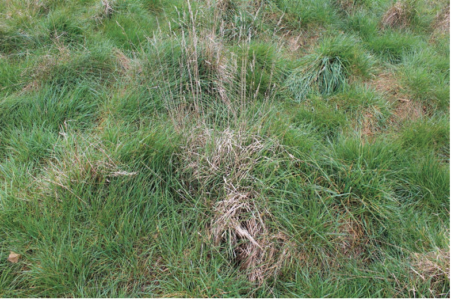Eamon Kealy, turfgrass specialist and lecturer in horticulture at the Institute of Technology Blanchardstown, sets out a concise strategy for managing areas of heavy rough on Ireland’s golf courses
Increasing pressure on golf course budgets has made superintendents reconsider how they manage their heavy rough grass and out of play areas. It is no longer feasible to intensively manage all the grassland areas on a golf course due to the increased cost of diesel, equipment and labour. Members and green fee paying golfers expect challenging conditions, yet enjoyable rounds of golf. Unmanaged rough areas can spoil a round of golf. They can frustrate players due to lost golf balls or injuries caused to golfers from playing heavy lies. The ideal rough penalises a poorly struck shot but does not prevent the golfer from locating and advancing the ball to some degree.
The heavy rough or deep rough on a golf course is the most important grassland habitat from an ecological point of view. It is usually allowed to grow throughout the season and only cut once or twice annually. It provides refuge for mammals and insects and can form part of the broader wildlife corridor throughout the course. Greens, tees and fairways are all intensively managed and provide little protection for mammals. Collectively woodlands, hedgerows, watercourses and heavy rough can be viewed as a precious sanctuary for flora and fauna. Poor management and maintenance of these long grass areas can lead to a general thickening of the sward over time. Prolonged instances of wet weather can have an undesirable impact on the sward composition, favouring grasses like Lolium perenne, Dactylis glomerata and Holcus lanatus. In such cases efforts to encourage finer species can be to no avail.

In recent years, superintendents have become proactive in developing management strategies and plans to reduce the density of the heavy rough on the golf courses. Approaches have revolved around reducing the soil fertility by harvesting grass and preventing the breakdown of nutrients back into the soil, effectively starving the coarser grasses. In 2009, a new selective graminicide, Rescue, was introduced onto the market targeting Lolium perenne and other coarse grasses. When used in combination with cultural techniques it can reduce the density of heavy rough areas. It can also be used on Festuca spp. golf greens.

THE MANAGEMENT PLAN
The objective of a management plan should be to alter the sward composition of the heavy rough over a period of time, by a combination of cultural and chemical techniques. Encouraging finer grass species and reducing sward density should be a priority. When developing a plan, areas along the fringes of play should be prioritised, as they have the most impact on play and subsequently the speed at which the game is played. Superintendents must survey and record the species of grasses in the areas to be treated. Any subsequent treatments will be based around their recordings. If the survey reveals high levels of desirable grasses like Festuca and Agrostis spp., then the strategies should revolve around maintaining and increasing these levels. However, should the survey reveal high levels of coarse grasses such as Lolium, Holcus and Dactylis spp. then all efforts should target reducing the prevalence of these grasses.
Getting the ideal sward composition doesn’t happen overnight. The superintendent must have the full backing of the golf club’s committee or owners. Plans may need to be in place for five to six years in order to be considered successful. With regard to informing the members of the club, communication is key. Often new management techniques can be misunderstood by the golfing public if they are not properly informed. During transition phases, areas of heavy rough can look weak and unkempt. It is at these times that a good management plan which has a solid basis in good agronomical practices is worth its weight in gold. There are a number of approaches that a superintendent can take regarding implementing a plan.
“Increasing pressure on golf course budgets has made superintendents reconsider how they manage their heavy rough grass and out of play areas”
The following management plan is an example of a combination chemical and cultural strategy, although I am not implying that a cultural only strategy would be less successful.
IMPLEMENTING THE MANAGEMENT PLAN
Surveying the Areas
Superintendents must have good turfgrass identifi cation skills to survey and record the species of grass that dominate the rough on their golf courses. Applying chemicals to reduce grass species that don’t exist in the sward would be a waste of time, energy and money. Two good reference sources for superintendents and greenkeepers looking to increase their knowledge of grasses are: ‘Grasses’ by CE Hubbard and ‘Plant Material of Agricultural Importance in Temperate Climates’ by MA Farragher. Both contain comprehensive identifi cation keys for both the vegetative and inflorescence stages of the grass’s life cycle.
When carrying out the survey, superintendents should use a quadrat to sample the areas to be included in the plan. Photographic records should be taken of the quadrats in position and percentage cover of both coarse and fine grass species should be recorded before any treatment takes place. The locations of each quadrat should be marked from two fixed points to ensure that follow up surveys are in the exact same position. Data collection is crucial to the successful execution of the plan.
Following a survey of the areas, in late summer/early autumn existing vegetation is cut and harvested to a height of 50mm. Ten days later, Rescue is applied at a rate of 1.0 l/ha when the grass is actively growing. The next spring, the vegetation is once again cut and harvested by March. Rescue is applied at a higher rate of 1.33 l/ha. The following autumn, the grass is collected and harvested again to reduce fertility. It should be noted that a maximum of two treatments of Rescue should be applied per annum.
Depending on the amount of undesirable grass in the sward, overseeding with finer grass species may be necessary after treatment to help the areas recover quickly. The area can be treated with a plant growth regulator such as Primo Maxx or Clipless before germination takes place. The plant growth regulator will give the germinating grass a better foothold in the first few weeks.
MAINTENANCE
After the initial targeting of small trial areas across the golf course in the first two years has been deemed a success, the management plan can be fully rolled out across the course with confidence. Continued monitoring and surveying by staff will be needed to ensure that the sward does not regress. The plan may need to be modified to adjust cutting times, rates of chemicals and harvesting plans should regression occur.
EQUIPMENT NEEDED TO IMPLEMENT THE PLAN
The heavy rough and out of play areas can make up a large portion of the entire golf course. Tackling large areas requires machines capable of cutting at low heights of cut (50mm) and harvesting the material. Many golf courses hire local agricultural contractors to carry out this work, as staffing levels are inadequate to complete in-house. Care should be taken to ensure the ground is sufficiently dry to take the weight of such machines and all access routes into and out of the course should be clearly defi ned to prevent damage to areas of high-value turf.

When implementing the plan on a smaller scale, combination machines like the Amazone Groundkeeper would be sufficient. Equipping the machine with scarifying blades to clean out the base of the sward will encourage the finer grasses to prevail once nutrient levels have been decreased. Such equipment also has the capability of harvesting grass clippings which can then be composted on-site if the facilities are available.

In Scotland, some links courses have brought sheep back to maintain Sites of Signifi cant Scientifi c Interest (SSSI’s). In such areas, invasive species are kept under control and rare plants can flourish. In the future, Irish golf course superintendents may revert to using sheep for grazing the heavy rough, thereby reducing the reliance on the use of machinery.
POTENTIAL PROBLEM SPECIES
Bracken: Heavy roughs can often have issues with invasive plants, such as bracken (Pteridium aquilinum). Asulox (a selective herbicide for treatment of bracken in grassland) was withdrawn from the approved pesticide register in December 2011 with a use-by date of December 2012. However, a temporary licence was granted for emergency use from 19th July 2013 to 16th November 2013. Bracken is extremely hard to control due to its reproductive mechanism. It spreads by underground creeping stems (rhizomes) and spores. Chemical treatment alone has varied success. Crushing of bracken is a method of control that has been used by land managers for decades. Crushing of the bracken plant has been shown to reduce the overall vigour of the plant by up to one third. The crushing of the bracken causes the plant to bleed sap for a number of days. This reduces the plant’s photosynthetic vigour and ultimately causes the death of the plant.
There are many beneficial effects of having bracken on the golf course. These include habitats for birds and cover for ground fl ora such as bluebell and violet. Dead bracken fronds provide cover for plants that otherwise could not compete with grass competition. Bracken is also used by badgers as bedding. However, from a golfi ng point of view, it is unsuitable due to its invasive characteristics.
IN BRIEF CONCLUSIONFor any plan to be successful it must be implemented in full and supported by staff and members alike. If the golf course is dependent on contractors for the harvesting of material, a good relationship should be developed with a contractor who understands the quality of work required on the golf course. Along with economic benefits, implementation of this type of plan can also have the following advantages for a golf course; ● The speed of the average round of golf decreases as golfers spend less time looking for golf balls in the rough. |
 EAMON KEALY M.Hort.Sc is a lecturer in horticulture, specialising in sports turf management at the Institute of Technology Blanchardstown. ITB offers part-time and full-time courses in horticulture. EAMON KEALY M.Hort.Sc is a lecturer in horticulture, specialising in sports turf management at the Institute of Technology Blanchardstown. ITB offers part-time and full-time courses in horticulture.
For more information see www.itb.ie or email info@itb.ie |




